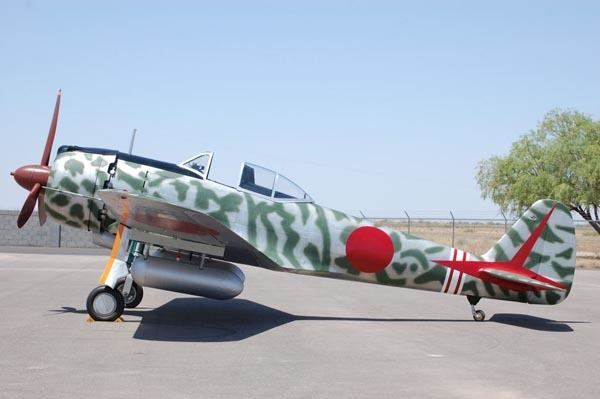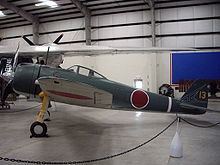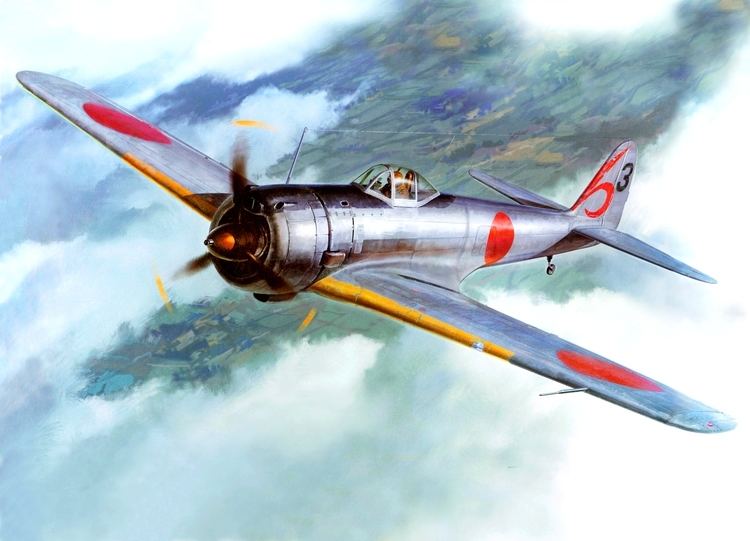Top speed 530 km/h Length 8.92 m Retired 1945 First flight 1942 | Wingspan 11 m Introduced October 1941 | |
 | ||
Nakajima ki 43 iiib hayabusa oscar
The Nakajima Ki-43 Hayabusa (隼, "Peregrine Falcon", "Army Type 1 Fighter" (一式戦闘機)) was a single-engine land-based tactical fighter used by the Imperial Japanese Army Air Force in World War II.
Contents
- Nakajima ki 43 iiib hayabusa oscar
- Nakajima ki 43 i hayabusa tenn heika banzai
- Design and development
- Operational history
- Variants
- Production
- Wartime
- Postwar
- Survivors
- Specifications Ki 43 IIb
- References

The Allied reporting name was "Oscar", but it was often called the "Army Zero" by American pilots because it bore a certain resemblance to the Mitsubishi A6M Zero, the Imperial Japanese Navy's counterpart to the Ki-43. Both aircraft had generally similar layout and lines, and also used essentially the same Nakajima Sakae radial engine, with similar round cowlings and bubble-type canopies (the Oscar's being distinctly smaller and having much less framing than the A6M). While relatively easy for a trained eye to tell apart with the "finer" lines of the Ki-43's fuselage — especially towards the tail — and more tapered wing planform, in the heat of battle, and given the brief glimpses and distraction of combat, Allied aviators frequently mistakenly reported having fought "Zeros" in areas where there were no Navy fighters.

Like the Mitsubishi-produced A6M Zero, the radial-engined Ki-43 was light and easy to fly and became legendary for its combat performance in East Asia in the early years of the war. It could outmaneuver any opponent, but did not have armor or self-sealing tanks, and its armament was poor until its final version, which was produced as late as 1945. Allied pilots often reported that the nimble Ki-43s were difficult targets but burned easily or broke apart with few hits. In spite of its drawbacks, the Ki-43 shot down more Allied aircraft than any other Japanese fighter and almost all the JAAF's aces achieved most of their kills in it.

Total production amounted to 5,919 aircraft. Many of these were used during the last months of the war for kamikaze missions against the American fleet.

Nakajima ki 43 i hayabusa tenn heika banzai
Design and development

The Ki-43 was designed by Hideo Itokawa, who would later become famous as a pioneer of Japanese rocketry. The Ki-43 prototype was produced in response to a December 1937 specification for a successor to the popular fixed-gear Nakajima Ki-27 Nate. The specification called for a top speed of 500 km/h (311 mph), a climb rate of 5,000 m (16,400 ft) in five minutes and a range of 800 km (500 mi). Maneuverability was to be at least as good as that of Ki-27.

When first flown in early January 1939, the Ki-43 prototype was a disappointment. Japanese test pilots complained that it was less maneuverable than the Ki-27 Nate and not much faster. In order to solve these problems, Nakajima produced a series of progressively modified prototypes through 1939 and 1940. These changes involved a major weight saving program, a slimmer fuselage with the tail surfaces moved further aft and a new canopy. Crucially, the 11th prototype introduced the unique differential "butterfly" maneuvering Fowler flaps, which dramatically improved performance in tight turns. The 13th prototype combined all these changes, and tests of this aircraft resulted in an instruction for Nakajima to place the Ki-43 into production, the Ki-27 jigs being transferred to the Mansyu factory at Harbin in Japanese occupied Manchukuo.
The Ki-43 (Oscar) was initially produced in November 1939, given the designation Ki-43-I. Deliveries from Nakajima's Ota factory commenced in February 1941. In addition to outstanding maneuverability, the Ki-43-I had an impressive rate of climb due to its light weight. Power was provided by the Nakajima Ha-25 engine turning a two-bladed, two-position variable-pitch metal propeller. Top speed was 495 km/h (308 mph) at 4,000 m (13,160 ft). The Ki-43 was equipped with two synchronized cowling machine guns in various configurations, with either two 7.7 mm (.303 in) Type 89 machine guns, one 12.7 mm (.50 in) Ho-103 machine gun and one 7.7 mm (.303 in) gun, or two 12.7 mm (.50 in) Ho-103 guns; the aircraft was given various sub-designations to reflect these differences. The configuration that appears to have been most prevalent at the outset of the war was the first configuration with two 7.7 mm (.303 in) Type 89 machine guns, while as the war progressed the heavier combinations gained popularity and the version with the heaviest armament was sometimes given the designation Ki-43-Ic. The Ho-103 was often loaded with explosive ammunition to increase target effect; its penetrative effect against later Allied aircraft armor appears to have been marginal.
Prototypes for the Ki-43-II flew in February 1942. The Ha-25 engine was upgraded with the 2-stage supercharger, thus becoming the more powerful Nakajima Ha-115 engine, which was installed in a longer-chord cowling. The new engine turned a three-bladed propeller. The wing structure, which had suffered failures in the Ki-43-I, was strengthened and equipped with racks for drop tanks or bombs. The Ki-43-II was also fitted with 13 mm armor plate for the pilot's head and back, and the aircraft's fuel tanks were coated in rubber to form a crude self-sealing tank. This was later replaced by 3-layer rubber bladder, 8mm core with 2mm oil-proof lamination. The bladder has proven to be highly resistant against 7.7mm bullets, but was not much effective against larger calibers. The pilot also enjoyed a slightly taller canopy and a reflector gunsight in place of the earlier telescopic gunsight. Nakajima commenced production of the Ki-43-II at its Ota factory in November 1942. Production was also started at the Tachikawa Hikoki KK and the 1st Army Air Arsenal (Tachikawa Dai-Ichi Rikugun Kokusho), also at Tachikawa. Although Tachikawa Hikoki successfully managed to enter into large-scale production of the Ki-43, the 1st Army Air Arsenal was less successful - hampered by a shortage of skilled workers, it was ordered to stop production after 49 Ki-43s were built. Nakajima eventually ceased production in mid-1944 in favor of the Ki-84, but the Tachikawa Hikoki continued to produce the Ki-43.
Tachikawa also produced the Ki-43-III, which utilized the more powerful Nakajima Army Type 1 Ha-115-II engine. Maximum speed increased to 358 mph. Tachikawa produced 2124 Ki-43-II and -III aircraft between April 1944 and the end of the war. Total production of all versions amounted to 5,919 aircraft.
Operational history
The Ki-43 was the most widely used Army fighter, and equipped 30th sentai FR,(flight regiment) and 12th chutais IS,(independent squadrons). The first unit equipped with the Ki 43-I was the 59th FR at Hankow Airfield, during June–August 1941. Operational sorties over Hengyang on 29. October 1941. The second unit to re-equip with the new Aircraft was the 64th FR, from August to November 1941.
The first version, Ki-43-I, entered service in 1941, the Ki-43-II in December 1942, the Ki-43-II-Kai in June 1943, and the Ki-43-IIIa in summer 1944. The aircraft fought in China, Burma, the Malay Peninsula, New Guinea, the Philippines, South Pacific islands and the Japanese home islands.
Like the Zero, the Ki-43 initially enjoyed air superiority in the skies of Malaya, Netherlands East Indies, Burma and New Guinea. This was partly due to the better performance of the Oscar and partly due to the relatively small numbers of combat-ready Allied fighters, mostly the Curtiss P-36 Hawk, Curtiss P-40, Brewster Buffalo, Hawker Hurricane and Curtiss-Wright CW-21 in Asia and the Pacific during the first months of the war. As the war progressed, however, the fighter suffered from the same weaknesses as the slower, fixed-gear Ki-27 "Nate" predecessor to the Oscar, and the more advanced naval A6M Zero; light armor and less-than-effective self-sealing fuel tanks, which caused high casualties in combat. Its armament of two machine guns also proved inadequate against the more heavily armored Allied aircraft. As newer Allied aircraft were introduced, such as the Republic P-47 Thunderbolt, Lockheed P-38 Lightning, North American P-51 Mustang, Vought F4U Corsair, Grumman F6F Hellcat and late-model Supermarine Spitfire/Seafire, the Japanese were forced into a defensive war and most aircraft were flown by inexperienced pilots. However, even near the end, the Oscar's excellent maneuverability could still gain advantage over rash Allied pilots. From October to December 1944, 17 Ki-43s were shot down in air combat; their pilots claimed seven C-47s, five B-24 Liberators, two Spitfires, two Beaufighters, two Mosquitoes, two F4U Corsairs, two B-29 Superfortresses, one F6F Hellcat, one P-38, and one B-25. Like most Japanese combat types, many Hayabusas were at the end expended in kamikaze raids.
The Ki-43 also served in an air defense role over Formosa, Okinawa and the Japanese home islands. Some examples were supplied to the pro-Japanese regimes of Thailand, Manchukuo and Wang Jingwei Government as well. The Thai units sometimes fought against the USAAF in southern China.
Hayabusas were well liked in the JAAF because of the pleasant flight characteristics and excellent maneuverability, and almost all JAAF fighter aces claimed victories with Hayabusa in some part of their career. At the end of the war, most Hayabusa units received Ki-84 Hayate "Frank" fighters, but some units flew the Hayabusa to the end of the war. The top-scoring Hayabusa pilot was Sergeant Satoshi Anabuki with 39 confirmed victories, almost all scored with the Ki-43.
After the war, some captured examples served in limited numbers in the French Air Force in Indochina against Viet Minh rebels.
Ki-43s abandoned in the Netherlands East Indies were taken over by the newly declared Indonesian government and put into service during the fighting against Dutch forces
Variants
Production
Not included:
Not included:
Wartime
Postwar
Survivors
Specifications (Ki-43-IIb)
Data from Japanese Aircraft of the Pacific War
General characteristics
Performance
Armament
